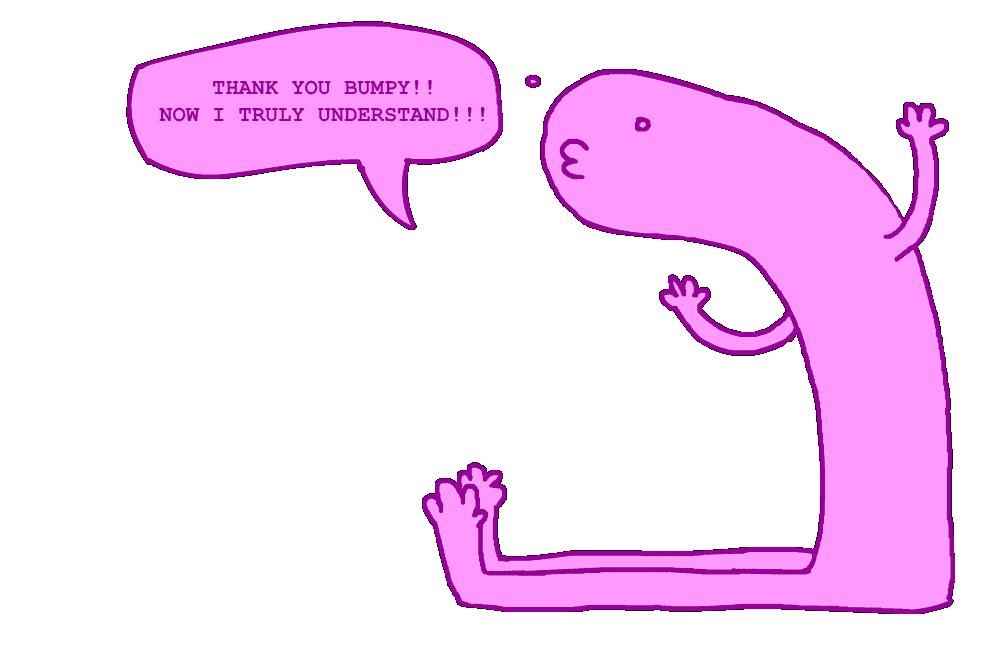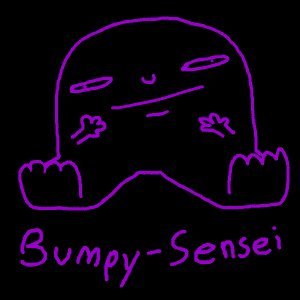
"pls dont making fun of me"

"pls dont making fun of me"
The most popular way of analyzing music in the West is through the lense of “Functional Harmony.” The West has put all of its chips into this method of analysis. Schenkerian analysis, Neo-Reimannism, counterpoint; any academic theory class you take will be a long-winded crash course on “Function.” What is functional harmony, you ask? It is basically when you write Roman Numerals underneath chords. It looks kinda like this:
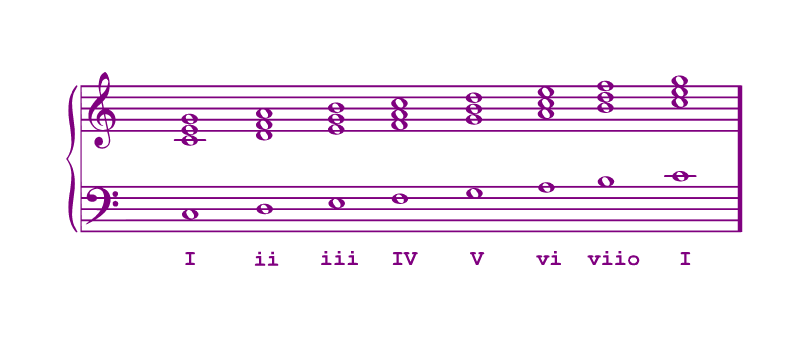
Pretty cool right? What’s the problem with that? The problem here is that functional harmony only explains Western music based off of the Classical “Church modes.” The idea here is to label chords based on their functional place in the 8-tone church scales. And that works for simpler music, but when you branch out into more complicated harmony, you get analyses that look like this:
other thing
And when encountering microtonlity, functional analysis becomes completely futile. Western academia leaned HARD into the theory of functional harmony; so, whenever it encountered compositions which didn’t work within this theoretical framework, it had to create a million exceptions to the framework's rules. Like, if you try to functionally analyze 20th century classical music, you’ll get a chord labelled viio/IV which is SUPPOSED to go to IV before moving on but actually it goes to a chord labelled N/V7 and then THAT ONE doesn’t resolve the right way (the FUNCTIONAL way). Then you get a chord that can’t even be labeled, so you try to explain it away “uhhhh that one note in the chord is just a suspension which doesn’t resolve.” And then you get to music that is “non-functional” and you're like "are fucking kidding me? what even is the point of this theory???"
So Functional Harmony is this severely overgrown, antiquated theory that doesn’t line up with reality. This guy named Arnold Schoenberg was a total master at Functional Harmony and even wrote a book about it. Yet, he was also the main guy pushing for “atonality” which is music where you… DON’T USE A TONAL CENTER??? One can only assume that he became so fed up with the inconsistencies of Functional Harmony that he completely opted out of using the tonic at all. And I think the path of poor, old Schoenberg is the path taken by many young composers: becoming so overwhelmed by the overcomplicated rules and exceptions of functional harmony that they completely reject the notion of a tonal center. When the most common system of harmony lets them down, musicians inevitably fall into the idea that there are no laws of consonance and dissonance; that dissonance is, itself, a subjective phenomenon which cannot be studied or measured.
What I offer is a way out. I want to show you that there is an objective and scientific way of studying the nature of consonance and dissonance. To study this phenomenon only requires that we forget all of our biases, that is, our immediate desire for practical compositional techniques, and meditate upon the basis of all harmony; to gaze through our musical compositions and see their most basic molecules. We must acknowledge what academia refuses to; the constant which dictates the harmonic idiosyncrasies of EVERY culture: THE HARMONIC SERIES.
The same people that are paid to teach us theory will hear about the Harmonic Series and be like “oh the first 6 notes of this thing are the major chord. thats pretty cool I guess” and they literally never think about it again. The universe left you a breadcrumb trail leading to the central laws of harmony, and you’re ignoring it to talk about this antiquated idea of function. And then you’re calling yourself a “music theorist.” What the fuck is wrong with you?
The microtonal community isn’t much better. They think the basis of all consonance is “le simple number ratios.” What does that even fucking mean? Blaming all consonance on “simple ratios” is such a cop-out. It’s almost an explanation for consonance, but there’s no depth to it at all. Like the theory of functional harmony, it leaves absolutely no room for nuance. This is why microtonalists will bash ratios together like rocks to create these gargantuan tuning systems. They are ratio-brained.
Know this, my friends: now that we have mediated on the progenitor of all harmony, we are a step ahead of all of these people. We have taken a moment to look behind all the fancy compositional techniques and worldly musical scales. And behind this layer of actualization, we have found the Harmonic Series, the unchanging tonal hierarchy which determines the laws of consonance and dissonance. Now that we’ve studied these laws, we can start applying them to real music. I will show you that the Harmonic Series can be embellished upon infinitely to explain harmonic nuances which the theory of functional harmony cannot.
We instinctively hear harmony from the bottom up. We are always listening for the 1, trying to hear it in the lower pitch-range where it’s usually found. Everything up above is heard as an extension of what is down below; NOT the other way around. So if I sit you in front of my piano and play the chord “G C D E” at a high pitch, your brain is gonna do the quick computations and imagine these tones, respectively, as the 6, 8, 9, and 10 of the harmonic series of a low C.
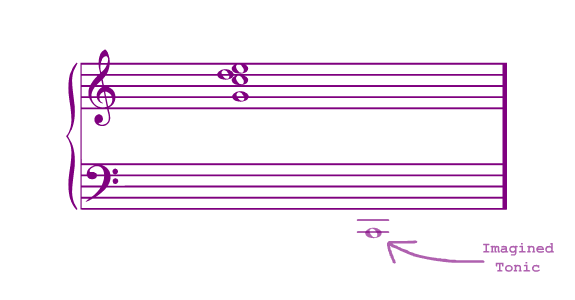
Now the low C is whats REALLY important here. It is… THE TONIC, the 1 of whatever harmonic series we’re working in. We’ve established a tonal solar system with C at its center; and every tone we play will fall into its orbit. If I were to play that low C after the chord, you would say “ohhhh that makes sense,” because I've illuminated what was already sitting in the back of your mind. So even if we can’t HEAR the tonic, our imagination makes it real and applies its gravitational pull to the audible tones. Indeed, imagined sound is just as real as the sound which is physically heard. When listening to music, we instinctually think a tonic into reality.
But here’s the fucked up thing: what if we play “G B D G” next.
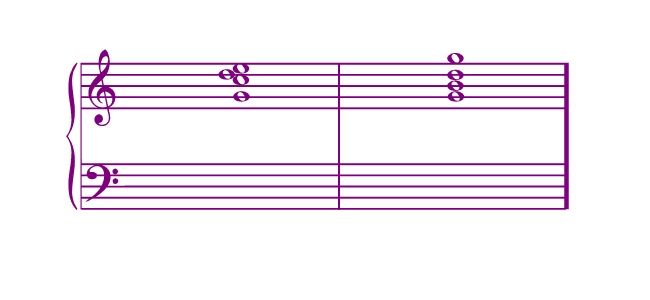
Maybe you think “oh ummmm 12, 15, 18, 24 maybe??” but then some intrusive voice in the back of your head whispers “those are high numbers bro. seems like kind of a stretch. what if that B is just a slightly detuned C?” Doubt. Panic. Dry-heaving. This is true DISSONANCE: the assumption that the NOTE ITSELF is WRONG. Since we relate everything to the harmonic series, a tone one half-step removed from the 8 (a very pure consonance) is immediately perceived as a detuned version of that tone. We are more likely to hear a G#, for instance, as the retarded cousin of G, than be like “noooo its just the 25erino of C!!!!!!!” Our ear is fundamentally cynical, always quick to condemn stray tones as dissonances. That intrusive voice in the back of your head is the devil letting you know that you just fucked up; you have distorted God’s beautifully pure harmonic series. You fucking monster how could you.
Do not fear though. There is a way to rectify this sin. So we’re in the harmonic series of C, right? Imagine we make a copy of the series and displace it so that the 1 is on G. We will treat the faux-series as a lesser version of our original. Everything in this faux-series exists on a layer below the primary series, so the tonic of this series will be secondary to that of the primary. And since the harmonic series is a hierarchy of tones, every tone produced by the secondary series will be less consonant than the corresponding tone of the primary series. Consider the secondary tonic to be a shadow of the primary where both are producing their own series.
In our example, we’re choosing G as our secondary tonic. This way, the “G B D G” is accounted for as the “4 5 6 8” of our secondary series. Even better, G is the 3 of C, so we’ve drawn a line connecting the B and the C. we still hear our primary tonic as C, but we also hear the 3 of C as a weaker, more temporary tonic. the G allows us to suspend our ear and hear consonance in these tones that SHOULD be dissonant to C’s harmonic series. The B was a “wrong note” before but now it’s the 5 of G; it is given a unique identity within our “second layer of tonicism”. This secondary layer, which is just a displaced version of the primary, acts as a home for any stray notes which can’t exist consonantly within the primary layer.
Next we’re actually gonna tune the B up to C and bring the D up to an E, making our third chord “6 8 10 12” of C:
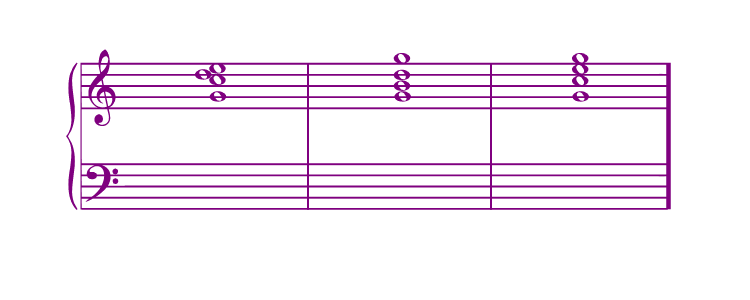
So, by the end, we are no longer using G as a secondary tonic! At its core, the second layer of tonicism is temporary, so classical musicians love to “resolve” back into the primary layer at the end of every song. That way, the primary tonic is affirmed as the one TRUE tonic. and even though we’re tuning the B back up to C, it doesn’t feel like we’re correcting a mistake; it feels like we’re taking a continuous, uninterrupted breath; expanding into the second layer and contracting into the primary layer. Yin and Yang. The G feels like it’s growing out from the C, so the entire “phrase” feels like one solidified form with C at its base.

Okay. I can see why you would say that. But I swear this isn't just a point about semantics. Let me give you another example.
What if I start with "G C D E" again. But THIS TIME my second chord is "F A C E":
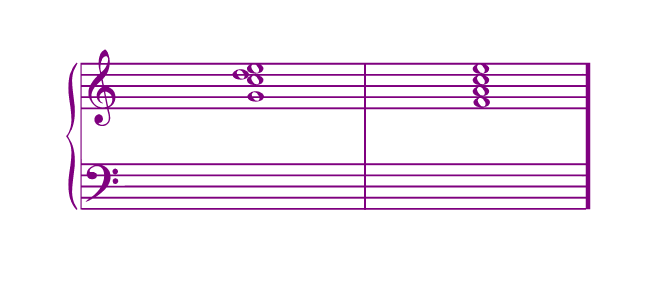
You can explain the A as the 27 (3x3x3) of C… but WHAT ABOUT THE F?!!! Here’s the thing about this F… if you’re tuning it correctly (as the 4/3 of C) then it’s not found in the harmonics of C at all! The harmonic series is an infinite set but none of the tones it reaches will ever be exactly octave equivalent to the perfect fourth! So there’s no direct way of tying this F to the harmonic series of C. Without the ability to suspend your ear into a second layer of tonicism, you would be forced to register the F as a sharpened E. Thankfully we can imagine the F as a secondary-tonic, and the really cool thing about this is that, now, C is not just the 1 of our tonic, it is also the 3 of our secondary-tonic. Our C has 2 separate meanings depending on the tonal-layer we are observing. The A makes more sense now too; instead of being a fucked up number like 27, it’s the 5 of the harmonic series of F. As before, we can resolve back into our primary tonic, this time by tuning the F down to E and the A down to G. with our final chord being “E G C E” (5 6 8 10), we have this:
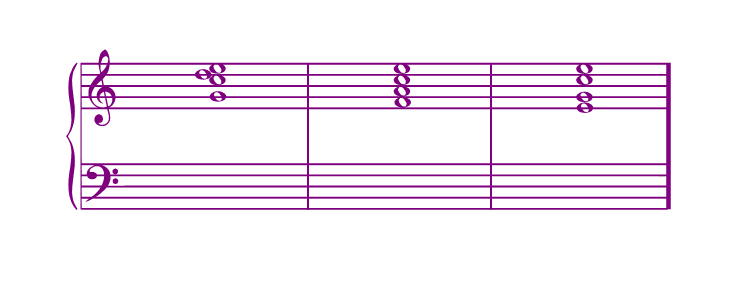
Same idea as before. Expansion and contraction away and towards the safety of our primary tonic. The F and G work notoriously well as secondary tonics to C, because G is the 3 of C, and C is the 3 of F. So these two secondary tonics have inverse-but-equal relationships to C.
I hope you understand what’s happening here. In both examples, we treated the outlier tones as dissonant by voice-leading them back into the harmonic series of C. but we also treated them as consonances of their own and indirect extensions of the C. by virtue of movement we have resolved consonance and dissonance with each other. By building separate layers of tonicism, we can expand the influence of our primary tonic so that it purifies even the most inherently dissonant tones. This is the true magic of complex tonality.
There’s theoretically no end to how much you can do this. We can keep building upon these tonal-layers to achieve even more complex harmony. For example:

Oh man so there’s a lot happening here. First important thing: the PRIMARY tonic is obviously C. No matter how complex the harmony gets, you always hear that imaginary drone down below. The first and fifth bars confirm that C is our tonal center, the first bar’s chord being “2 3 5 6 8” and the last being “1 2 3 4 5”. The tones in between those bars are all nuances off of the primary tonic, extensions of the C through time.
Next, notice that every second-layer tonic is being played in the bass. In this example, the lowest note always indicates the secondary tonic, and when there is no secondary tonic, the lowest note defaults to the primary tonic. This happens A LOT in music, because it’s the easiest way to indicate the second layer while allowing upper layers to do more complicated harmony in the higher registers. In the example I’ve also included the 5 of each secondary tonic, which most musicians don’t actually do. Since we hear music from the bottom up, our lowest note being the 1 of F is enough to convince us that F is our secondary tonic. You don't really need the 5 in there. Even so, I just want to demonstrate that these secondary-tonic-notes are more than just discrete bass notes; they are each implications of a unique harmonic series.
Bar 2 establishes a 2nd layer with F as the secondary tonic. In F, the tones are “2 5 6 8 12”. We’ve seen this before. Nothing too complicated.
Then on bar 3, the secondary tonic becomes G, and a THIRD LAYER OF TONICISM is established! On the first beat of this bar, the 1 and 5 of G plays down below; meanwhile, up above, “4 5 6” of E is played. Because all harmony reflects the harmonic series, tonal-layers are stacked from bottom to top. This is why our upper-layers will necessarily exist in the higher pitch-range. The lower pitches almost always imply a lower layer of tonicism. Just like in the harmonic series, the more direct consonances are found down below. Higher layers of tonicism can only be achieved in the higher pitch-ranges where they won’t clash with our lower tonics. So our lower-layered tonics, the C and G, are powerful and grounded consonances which connect unambiguously to the primary layer. In contrast, our higher tonic, in this case the E, is short-lived and airy, but beautifully light and free. The higher tonics float up in the air, cascading through bizarre tones that would never work in the lower layers. They explode into color like fireworks and then disappear quickly. Now that we’ve established a higher layer, we will start hearing these weird, unrestrained harmonic colors.
The juxtaposition of the third-layer E and the second-layer G is really cool because the 6 of E is the 5 of G. also the 5 of E is G# which can be imagined as a slightly sharpened G. So we’re rearing to tune that G# down to G and resolve back into the second layer, right? haha WRONG. What’s funny is while the G# was planning to resolve back into G, the B was planning a resolution of its own. while the G# was working on himself so he could become a G, the B was getting ahead of himself. “im not just the 5 of some secondary tonic” it thought. “what if instead of resolving into the second layer, we resolve ALL THE WAY BACK TO THE FIRST LAYER MUAHAHAHAHA” and so the B, instead of remaining the 5 of G, resolves UPWARDS to the 1 of C. Surely this means we’re back to the primary layer? NO. Although the upper notes are now “5 6 8” of C, the bass notes are still the 1 and 5 of G. Our secondary tonic gets the final say here. So although the top three notes are consonant with our primary tonic, they skipped resolving into the secondary tonic, which is still G. We are still working in 3 layers, and although the third tonic is the same as the primary, it is still heard in juxtaposition with the secondary tonic, therefore it remains a third layer. The top note’s scheme has failed. Too bad, dipshit. That’s what you get for ignoring the tonic-hierarchy.
But no big deal. Just resolve on the third beat, right? The third layer goes NAH and jumps all the way to Eb out of frustration. Our new upper chord is the “5 6 8” of Eb and oh cool the 5 of Eb is the 1 of G. These next three beats are tricky because the Eb will remain our third tonic, but on the fourth beat, we jump up to the FOURTH LAYER; our fourth tonic briefly becomes Ab so that its 3 will be the 1 of our third layer. Then in the first beat of the next bar, the fourth layer resolves back into the third. In these three beats, we have a nice little chord progression that, if played by itself, would sound just like our second example. But, by virtue of its placement in the fourth-layer of this example, the progression is SO MUCH MORE INTENSE. Notice that when the fourth layer rears its head, this is the height of the tension. The more layers of tonicism, the more energy is required to keep them tied together. When reaching high layers, the string connecting the upper and primary tonic is pulled near its breaking point; at some point, it becomes really hard to keep this “string” from breaking, but if you can make it work, you are rewarded with some of the most painful-sweet climaxes in music. Here’s where a good musician can really show off and turn tonal-layering into musical storytelling. Here is where musical architecture becomes drama.
Anyways, we descend from our climactic fourth layer. Bar 4, beat 2: our second tonic is still G holy shit. In our third layer, the “3 4 5” of Eb shifts down to a “3 4 5” of D. This is parallel motion which just means that all of the tones are shifting exactly the same distance in the same direction. Honestly, these parallel-type chord progression sound really mechanical most of the time which is why baroque people hated “parallel fifths”. See, in the baroque period, people wrote a lot of music about Jesus; specifically about the part of Jesus’ life where he got crucified. To reflect this gory, painful scene, they wrote their music to be as gooey and fleshy as possible. Listening to a Bach chorale is like biting into a chunk of rare meat; you can taste the blood. The parallel fifth (and really any parallel movement of consonant intervals) sounds less like rare meat and more like gears churning, so the baroque guys avoided it whenever possible. But the French impressionists LOVED this shit. These late-1800s French guys were super ironic aesthetes who didn’t really care for the whole Jesus thing, so they felt no need to make their music painful torture-porn. They weren’t afraid to move a solid block of “1 3 5” all over the place for eight bars. Debussy especially loved this; if he found a chord-voicing he liked, he kept it rolling as long as he could. “FUCK VOICE LEADING” says Debussy.
Sorry. That was just a short footnote on parallel motion. Back to the example:
So this “3 4 5” of D also works as the “9 12 15” of G. We could resolve that F# up to a G and finally be out of this third layer, but instead we’re gonna go… down to F??? Oh wait that’s not just any F; that’s the 7 of G. It’s easy to forget about the 7 sometimes. Aren’t you glad we talked about it? Anyways, that F is gonna be our third tonic, so the 1 of our third layer is the 7 of our second layer. Finally, we’re gonna sustain that F but resolve everything else to the “1 3 5” of G, depriving the F of its identity as a tonic.
We are finally back to the second layer and our full chord is “2 5 8 10 12 14” of G. What’s really cool about this chord is that, in relation to our primary tonic, the F feels like a sharp E and the B feels like a flat C. Even cooler: these 2 notes (F and B) are at a really gross interval with each other but we push them towards each other just a little to resolve them to a really NICE interval. And that’s just what we do in bar 5: the G stays the same, the F resolves downwards, and the B resolves upwards. There goes the second layer. We have resolved into a nice “1 2 3 4 5” of C; our primary layer. Now we breathe a sigh of relief. All that layer-stacking paid off. It was all just C the entire time. But the real C was unironically the weirdo shit we played along the way.
I really just wanted to show how even the most complicated and strange harmonies are still just embellishments upon the Harmonic Series. This is what all harmony truly is! Tonal embellishments! There are many ways to "embellish", but the idea of "Tonal Layering" explains most Western Classical music far more adequately than does "functional harmony." Reimann, and Schenker, and Schoenberg would not be able to functionally explain the final example. They might even cop-out by referring to the final example as "non-functional harmony." But the example makes sense when viewed as an assembly of multiple tonal layers. And, although the theory of tonal layering is not all-encompassing, it does explain the direct relation between Western harmonic practices and the all-encompassing Harmonic Series. Through the lense of tonal layering, most Western music can be tied to the Harmonic Series from which it unconsciously derives. What I mean to demonstrate in the long-term is that ALL harmonic practices are unconscious derivations of the Harmonic Series and should be treated as such.
In music, the eternal and unchanging Harmonic Series is paradoxically given "breath." Remember that the every tone is simultaneously itself AND the infinite tones within its harmonic series. In this way, the tonic contains infinity. Every harmonic movement is an elaboration upon this infity. Harmony is simply the the tonic expressing itself, over time. It is the 1, the SINGLE TONE, given life by virtue of movement.
